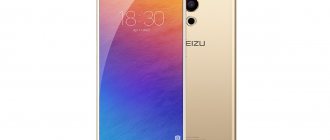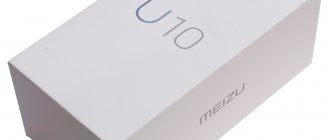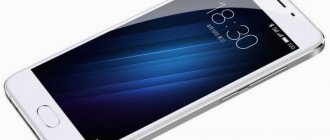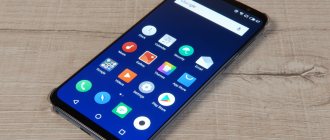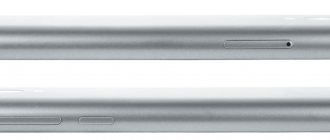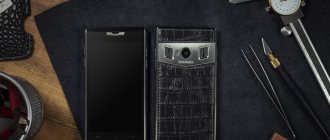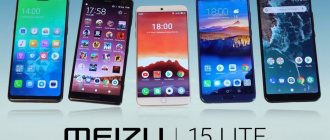Meizu 16X
The smartphone has a 6.01-inch AMOLED display with a resolution of 2160×1080 pixels and an 18:9 aspect ratio, a fingerprint scanner built under the screen and a dual camera on the back.
The main difference from the flagship 16th is the processor. The presented new product received a Snapdragon 710, which is complemented by 6 GB of RAM. The drive is available in 64 and 128 GB options. The main camera is equipped with Sony IMX 350 and 380 modules of 12 and 20 megapixels, the front one is 20 megapixels. The 3010 mAh battery supports mCharge 4.0 fast charging at 24 W and provides up to 16 hours of continuous operation of the device.
Price of Meizu 16X in China:
- 6+64 GB - 2099 yuan (about 21,000 rubles);
- 6+128 GB - 2399 yuan (about 23,500 rubles).
Later, the new product will appear in Russia - then its Russian cost will become known. The smartphone is available in blue and black body colors.
Other parameters
We have collected everything that does not distinguish this smartphone from its analogues, is the modern norm and does not affect the price, in a separate section. There is no point in paying special attention to this.
SIM card slot:
- 2 nano SIM cards in standby mode.
mTouch fingerprint scanner:
- Recognition angle: 360 degrees.
- Sensor: capacitive fingerprint scanner.
Connection:
- 4G: FDD-LTE (B1, B2, B3, B4, B5, B7, B8, B20).
- 4G: TD-LTE (B40).
- 3G: WCDMA (B1, B2, B4, B5, B8).
- 3G: TD-SCDMA (B34, B39).
- 3G: CDMA (BC0).
- 2G: GSM (B2, B3, B5, B8).
WLAN:
- Wi-Fi (2.4/5 GHz).
- 11 ac/b/g/n.
Bluetooth:
- Bluetooth 5.0 BLE.
Navigation:
- GLONASS.
- Digital compass.
Sensors:
- Gravity sensor.
- Hall Sensor.
- Infrared sensor.
- Gyroscope.
- Light sensor.
- Digital compass.
- Fingerprint's scanner.
Multimedia:
- Video: MP4, 3GP, MOV, MKV, AVI, FLV, MPEG, M2TS, TS.
- Audio: FLAC, APE, AAC, MKA, OGG, MP3, MIDI, M4A, AMR, WAV.
- Image: JPEG, PNG, GIF, BMP.
Working environment:
- Ambient temperature: -0°C to 35°C.
- Storage temperature: -20 to 45°C.
Meizu X8
The new product was the first Meizu smartphone with a cutout at the top of the screen. The device received a 6.15-inch IPS display with an aspect ratio of 18.5:9 and FullHD+ resolution, a Snapdragon 710 processor, 4 or 6 GB of RAM and a 3210 mAh battery. There is 64 or 128 GB of user space for storing data and applications.
The main camera received two 12-megapixel Sony IMX362 sensors with f/1.9 aperture and Dual Pixel technology. The front module has a wide-angle lens of 20 megapixels. There is Bluetooth 5.0, support for fast charging and a USB Type-C port. Three body colors: blue, black and white.
Price of Meizu X8 in China:
- 6+64 GB - 1799 yuan (about 17,500 rubles);
- 6+128 GB - 1999 yuan (about 20,000 rubles).
Screen characteristics
There may be a little confusion with the screen, since either 6.15” or 6.2” is indicated. The fact is that the first number shows how much the display occupies, and the second shows the total area of the front surface.
Full list of X8 screen options:
- Diagonal: 6.2".
- Screen proportions: 18.5:9.
- Resolution: 1080×2220.
- Contrast: 1500:1.
- Pixels per inch: 401.
- Brightness: 450 cd/m2.
- Side frame thickness: 1.7 mm.
- Top and bottom frame thickness: 4.8 mm (including speaker and camera).
- Matrix: IPS.
Comparison with competitors
To select top models, we filtered by the following parameters: IPS, diagonal larger than 6.15” and frameless. The last condition could be omitted, but sellers abuse this parameter, replacing the concepts of screen diagonal and front side diagonal. Therefore, the frameless filter allows you to select screens with the maximum usable area.
Fortunately or not, only three Chinese devices fit these parameters: Huawei Mate 20 Lite and Novo3, Honor Play.
Since all top models have the same height of 1080 pixels, it is appropriate to calculate the difference by the total number of pixels. For example, 1080×2220=2397600. By the way, it follows from this that there is no need to compare by the number of pixels per inch.
Screen, resolution:
| Our smartphone | Honor Play | |
| Permission | 2397600 | 2527200 |
| Resolution in % | 94,87% | 100% |
| The right price from the top | 21155 | 22299 |
Maximum brightness (white):
| Our smartphone | Huawei Mate 20 Lite | |
| Brightness | 450 cd/m2 | 460 cd/m2 |
| Brightness in % | 97,82% | 100% |
| The right price from the top | 22302 | 22799 |
Contrast:
| Our smartphone | Huawei Nova 3 | |
| Contrast | 1500:1 | 1531:1 |
| Contrast % | 97,98% | 100% |
| The right price from the top | 29197 | 29799 |
As a result, we find that the average cost based on screen characteristics is 24,218 rubles, but let’s continue our study.
Full screen characteristics:
- Diagonal – 6.2 inches.
- Resolution – 2220 x1080.
- Contrast – 1500:1 (average).
- The number of dots per inch is 401.
- Brightness – 430 cd/m2 (average).
- Made using In-Cell technology.
Meizu V8 and V8 Pro
V8 and V8 Pro are the most affordable smartphones available today. They received a 5.7-inch HD display, a Helio P22 processor and a fingerprint scanner on the back of the case. V8 got 3 GB of RAM and 32 GB of flash memory, a 13-megapixel main camera and a 3200 mAh battery. V8 Pro is equipped with 4+64 GB of memory, a dual camera with 12 and 5 megapixel modules, and a 3100 mAh battery.
Now the new products are sold only in China, and will arrive in Russia in the fall. Price:
- V8 - 799 yuan (about 8,000 rubles);
- V8 Pro - 1099 yuan (about 11,000 rubles).
Smartphone camera
It is stated that the main camera has Sony IMX362 and Samsung 2L7 modules with a larger aperture and a pixel size of 1.4 microns. The part is also equipped with a 6-component lens using the ArcSoft portrait optimization algorithm.
The ability to take selfies is highlighted as an advantage since more megapixels are given to the front camera. All this is provided with the wording “fast dual autofocus”.
That is, it is clearly defined that the smartphone is intended for those who like to create something “for themselves.” For this, various effects are provided, for example, professional “bokeh” - defocusing the screen.
Comparison with competitors
The top model for the camera in this review is determined by the number of lenses on a particular side, but a separate model is selected for each characteristic. At this moment, even on the official website, the maximum photo resolution and a number of other characteristics have not been announced, so the quality of the camera is determined by five parameters.
Rear (main) camera, megapixels:
| Our smartphone | Honor 10 Premium | |
| Megapixels | 12 MP | 24 MP |
| Megapixels in % | 30% | 100% |
| The right price from the top | 10499 | 34999 |
Rear (main) camera, aperture:
| Our smartphone | Honor 8X | |
| Diaphragm | ƒ/1.9 | ƒ/1.8 |
| Aperture in % | 94,7 | 100% |
| The right price from the top | 17036 | 17990 |
Rear (auxiliary) camera, megapixels:
| Our smartphone | Honor 10 | |
| Megapixels | 5 MP | 16 MP |
| Megapixels in % | 31,25 | 100% |
| The right price from the top | 8437 | 26999 |
Front (front) camera, megapixels:
| Our smartphone | Samsung SM-A605F Galaxy A6+ | |
| Megapixels | 20 MP | 24 MP |
| Megapixels in % | 83% | 100% |
| The right price from the top | 14939 | 17999 |
Front (front) camera, aperture:
| Our smartphone | Samsung SM-A605F Galaxy A6+ | |
| Diaphragm | ƒ/2.0 | ƒ/1.9 |
| Aperture in % | 95% | 100% |
| The right price from the top | 17099 | 17999 |
We conclude that with such a camera the price of Meizu X 8 should be at the level of 13,602 rubles. But don't rush it, as there are many other factors that can affect the final eligible retail price.
Full camera specifications:
Main (rear):
- 12 MP – basic and 5 MP – auxiliary.
- Image stabilization (base camera).
- Dual autofocus (basic camera).
- Aperture ƒ/1.9.
- Bokeh effect of blurred background.
- Dual ISP image signal processor.
- Serial shooting.
- Shooting a panorama.
- 6-element base lens + 4-element auxiliary lens.
- Dual two-color flash.
Front:
- 20 MP.
- Aperture ƒ/2.0.
- Blurred background effect.
- 5-element lens.
- Selfie editor ArcSoft.
- Fast facial recognition using artificial intelligence.
- Face A.E.
EP52 Lite and Meizu 3 PowerBank
The wireless headphones are protected from moisture according to the IPX5 standard and will operate on a full battery charge for up to 8 hours. The accessory is available in three colors: black, white and blue. Cost: 129 yuan (about 1,300 rubles).
Meizu 3 with 10,000 mAh has a slightly updated body design and supports 18-watt fast charging.
The cost in China is 79 yuan (about 750 rubles). iGuides in Telegram - t.me/iguides_ru iGuides in Yandex.Zen - zen.yandex.ru/iguides.ru We give gifts for the best blog articles
i-SHOPPERS.net - product reviews and reviews of online stores
I managed to snatch this smartphone in the global version during the November sale on Aliexpress on pre-order for $213. Meizu X8 is already available officially (in Russia, Ukraine) and the officials are asking 20,000 rubles for it. in Russian retail. And at the time of ordering, I considered this model very promising: nice design, powerful, fresh processor, reasonable price tag. Well, let's see what Meizu did this time.
EQUIPMENT
— fast charging unit, — USB-C cable, — branded key, — user manual.
DESIGN
Of course, even at the order stage I understood that I was dealing with a smartphone that did not have a practical body, but what can I do - these are the trends. Before us is another glossy smartphone, and even with a plastic back panel. Plastic does not bend, does not creak and is as similar as possible to glass. As they say, thanks for that.
And also my respect to the designers for not varnishing the ends - we have matte metal. There are two perforations at the bottom: for the speaker and microphone, and between them is a USB-C port. My other thanks go to Meizu for keeping the audio jack - it’s on the top end.
But I can’t write any respects for the tray, because the tray here isn’t even a hybrid one – only 2 nanoSIM cards and no memory cards.
The main dual camera protrudes quite a bit beyond the body and again we have Meizu with a fingerprint scanner on the back, which this company previously tried to avoid in every possible way. The scanner works well, there are no questions about it.
There is only one complaint about the assembly - the power and volume buttons are noticeably loose, hanging out in their niches, fortunately at least they don’t rattle when shaken.
I would also like to note the comfortable dimensions of the Meizu X8: length 151 mm, width 74.5 mm, thickness approximately 7 mm, although according to the passport it is 7.8 mm, but this takes into account the protrusion with the camera. The ergonomics are good, pleasant, but of course it is slippery.
Another element that Meizu has avoided until recently is the so-called bangs. But the X8 broke the system, it follows trends and here, after all, bangs appeared. But Meizu implemented the protrusion in an original way. Yes, the unibrow is long, but very narrow and even looks pretty in its own way. There is a single-color LED indicator to the left of the speaker. And whatever one may say, the protrusion still limits the notification panel, which can only accommodate 2 notifications; the rest can be seen in the curtain.
The bottom frame of the display is narrow and elegant. The corners of the screen are rounded – this is again a trend. And it’s nice that when playing videos, as well as in games, the display looks symmetrical, because the bangs are automatically hidden, and the corners on the side of the cutout are rounded programmatically.
DISPLAY
The display itself in Meizu X8 is naturally IPS, with a diagonal of 6.2 inches and a FullHD+ resolution. In terms of color rendition, viewing angles, brightness range, and responsiveness of the touchscreen, everything is fine. A good screen that won't disappoint. The only point I can find fault with is a slight, barely noticeable darkening at the bottom of the display, which can be seen against a white background. But this is not a defect or a problem with a particular model. I often see similar uneven backlighting on many smartphones with narrow frames, and this fact can be attributed to design features. It's not fatal, and most people won't notice it at all.
HARDWARE
Snapdragon 710 is a fresh chip, released in 2018, taking away the title of pre-flagship chip from Snapdragon 660. Now it is the 710 that leads the segment of mid-price mobile processors. It also has a technological process that can be said to be flagship – 10 nm. It has a fairly powerful Adreno 616 video chip. And 8 Kryo 360 cores are divided into 2 clusters: two powerful cores with a maximum frequency of 2.2 GHz + six economical cores with a frequency reduced to 1.7 GHz and due to this we get an excellent balance between performance and energy efficiency. The smartphone does not get hot even in games – the processor heating did not exceed 46 degrees. after an hour of play. Well, the 710th “dragon” copes with the games themselves with a bang. For example, in tanks (WOT Blitz) you can safely turn on maximum graphics - yes, occasionally, during moments of action, FPS will briefly drop to 30 fps, but playability does not suffer from this. PUBG Mobile automatically sets high graphics when starting, and with these settings I quite comfortably ran around the map and killed virtual adversaries.
Well, with memory everything is simple - either 4/64 GB, or the older version 6/128 GB. The RAM is LPDDR 4X dual-channel, the drives are used by EMMC and don’t forget about the lack of support for memory cards.
SOFTWARE PART
As I already said, I have the global version of Meizu X8 and here we get Flyme 7.1.7.0 + Android 8.1.0. There are no updates at the moment and when they will appear is a difficult question: you all probably know that Meizu supports its smartphones extremely reluctantly and this is their disease. We have already seen the 7th Flyme itself in Meizu Note 8. There are not only on-screen buttons and a virtual multifunctional mBack button, as well as gesture control, but it is still crude - for example, with gesture control, if you are watching a video or racing The toy is in landscape mode and you want to minimize the application, you won’t succeed - the menu of background applications appears, but not all the way, and in the end you can’t minimize the program, you just have to either exit it or return to it. At the same time, with a vertical arrangement, everything works as it should. This is called starting dampness.
Another important nuance that many people complain about. A lot of programs do not want to be installed from the Market - you see a red message that the application is not supported by your smartphone. Among such applications are Instagram, WOT Blitz, Antutu 3D benchmark, etc. The problem is solved in just a couple of seconds. We select Market in the list of applications and simply click “Erase data” - after that all applications are installed normally through the Market and we say goodbye to this problem. Well, Flyme himself is not an acquired taste. The interface certainly has the right to life, although it lacks some of the features available in other shells.
OTHER FUNCTIONALITY
The situation with face recognition here is exactly the same as in Meizu NOTE 8. It is impossible to fully use this function, because even with a slight deterioration in lighting, the smartphone simply does not recognize you.
You will most likely like the multimedia speaker, because it is actually quite good. The smartphone sounds fine. And the sound in the headphones absolutely satisfied me. And don’t forget that the standard Flyme player has the Square Sound option, where you have various sound presets and a full-fledged equalizer at your service.
Well, since we have Meizu in front of us, we don’t even remember about the NFC module. There is no FM radio, by the way. WiFi is dual-band, everything is fine with it. I also had no problems with communication, and I was absolutely satisfied with audibility.
CAMERAS
The camera in the Meizu X8 is 12 MP + 5 MP with an f/1.9 aperture, and here the situation is the same as we once observed in the case of the Meizu M6 Note - the manufacturer does not hide the fact that you may come across either a Sony IMX362 sensor or and Samsung 2L7 as the main sensor. Official random. But the main thing is that the optics do not fail and the software processing is at a good level. Like Note 8? there is a fast digital zoom button, there is automatic scene recognition, which is now commonly called by the big name “Artificial Intelligence,” and there is automatic HDR.
In the daytime, almost all of my test frames turned out successful - not blurred, clear, and in general I liked the camera during the day. You can also install a Google camera here, but it is better to use it in low light, because, I repeat, during the day the X8 shows excellent results even on stock. The double flash illuminates the frame correctly, without overexposure. But even with a lack of light, the camera did not disappoint me. And I was interested in comparing the X8 with the Meizu NOTE 8, because they have the same sensors, but logically the X8 simply has to take better pictures, like a more expensive smartphone. And so it is. Detail is definitely better on the X8. Either due to improved optics, or due to software, or all together, but the fact remains a fact. In general, everything is fine with the photo mode.
You can shoot video in both FullHD 30 FPS and 4K. Here, too, everything is good in quality, but Meizu’s main problem is the lack of normal stabilization when shooting video. So you will have to stabilize the videos through third-party software. There is also shooting in Slow Motion mode.
The 20-megapixel front camera with F/2.0 aperture and 5-element lens is perfect for selfie lovers.
DOWNLOAD SOURCES FROM CAMERAS HERE>>
AUTONOMY
When you look at the battery capacity, which is 3210 mAh, these numbers automatically make you sad. In fact, there is no reason to be sad - the Snapdragon 710 uses its charge carefully and as a result, even with such a capacity, we get confidently good battery life, at least not below average. Firstly, there is no battery waste in standby mode - during a classic 8-hour night, no more than 2% of the charge is consumed, and sometimes even 1%. Video playback in 720p quality online via WiFi – 11 hours 50 minutes without interruption. In game mode, we say goodbye to 18% for 1 hour of online play, again via WiFi.
Fast charging mCharge shows the following speed: in 30 minutes. we get 42%, in 1 hour - 77% and the total charging time is 1 hour 45 minutes.
VERDICT
What's left? What we end up with is a smartphone with the following disadvantages: a plastic back panel, slight dampness typical for the launch firmware, and for some, the lack of NFC will be a disadvantage. An absolute plus is the processor, and I’ll probably also count the camera as an asset, I liked it. Otherwise, this is a completely balanced smartphone. And of course, your attitude towards this or that brand plays a huge role in your choice, and if you don’t like Meizu and its Flyme, then no “dragon” will make a difference here. Well, those who like this brand can be advised to take a closer look at the X8 - of the latest Meizu, this is perhaps the most interesting device in the $200+ segment.
WHERE TO BUY MEIZU X8:
- on Aliexpress global version: ONE>>, TWO>> - prices in Russian stores SEE HERE>>
SAVE WITH CASHBACK:
- universal CASHBACK SERVICE>> with many online stores - convenient browser extension for tracking cashback and price dynamics in stores and on ALI INSTALL HERE>>
VIDEO VERSION:
Camera settings
Meizu V8 rear camera
This device is equipped with a single 13 megapixel camera module. Its aperture is f/2.2. Such optics are not the brightest in the budget segment of devices. In addition, the gadget does not have optical stabilization, and there is no accurate autofocus data at all. The flash is located at the bottom, immediately below the module. It is possible to enable the option to improve portraits. This function works in smart mode. In daylight the pictures are good, but in the evening there is noticeable noise.
Meizu V8 front camera
This module also does not stand out in any way. Its resolution is 5 megapixels and the aperture is f/1.9. Everything is simple, no frills, so you shouldn’t expect high-quality selfie shots. To make video calls, such indicators will be quite enough. There is no flash for the front camera.
Rear camera of Meizu V8 Pro
Another distinctive feature of the device is the presence of a dual main camera module. The resolution of one sensor is 12 megapixels, and the additional one is 5 megapixels. The aperture characteristic of the smartphone is f/2.2. Among budget devices, it is quite rare to find such a camera, while this remains the privilege of flagships. Therefore, the device stands out strongly in this parameter.
But there are also some disadvantages. It has phase detection autofocus, so it won't be very accurate in some scenes. But there is no optical stabilization at all. Useful features include an intelligent mode for enhancing portrait shots and the ability to recognize faces in the frame.
The camera's image resolution is 4000 by 3000 pixels, and video file resolution is 3840 by 2160. The maximum number of frames per second is 30.
Front Meizu V8 Pro
Everything here remains the same as the first gadget - a shooting resolution of 5 megapixels, an f/1.9 aperture and the absence of a front flash.
Smartphone design and dimensions
In terms of visual characteristics, the X8 model is practically no different from the Meizu 16/16th. The main difference is the location of the LED flash: in the smartphone in question it is located on the back panel above the camera modules, and in the 16th series the flash is located below and has a round shape. The rest of the style is the same.
In 2018-2019, Meizu chose a corporate style for itself, because all gadgets received one recognizable design. All smartphones turned out to be compact, ultra-thin, and they also fit comfortably in the hand, while being large in size. After several months of test use of the 16th and X8 models, it is worth noting that they are among the most ergonomic smartphones in their size.
On the back side, Meizu X8 has multi-layer coated glass. Fingerprints, hand dirt and other contaminants stick well to it. Another specific feature of glass is that small scratches gradually accumulate on it. Along the edges of the smartphone there is a metal frame, which is painted in a single color, identical to the color of the case.
There is also glass on the front, but it is more resistant to small scratches; at least none appeared during the test. A very high-quality oleophobic coating is applied on top of the screen.
In the area of the screen cutout there are:
- ambient light level sensors;
- LED event indicator;
- proximity sensor;
- speaker for communication. You can hear it very well, even in the subway speech remains intelligible and quite clear;
- The rightmost element is the selfie camera.
Regarding functional elements:
- on the right side there is a lock button and a volume control;
- on the left there is a tray for installing 2 SIM cards;
- on the bottom there is a conversational microphone, a USB Type-C port and a multimedia speaker, also known as a loudspeaker;
- A 3.5 mm headset output is installed on top;
- The back cover has a dual LED flash, a dual camera sensor, and a fingerprint scanner.
Dimensions of the smartphone: 151x74x7.8 mm, weight 60 g.
Meizu X8, M8 and M8 Lite
So, on September 19, Meizu presented a full-fledged and very cool sub-flagship Meizu 16X, as well as three more cool and inexpensive devices, but with simplified characteristics. We wrote about the 16X model here, but we have not yet looked at the other three devices. It’s worth filling this gap, especially since the devices are really worthy of review. Moreover, each device is worthy of a separate review, but for now let’s take a brief look at them in order to have at least some idea about their parameters and prices. By the way, if you were suddenly looking for the Meizu V8 and V8 Pro models, then you are at the right place. The thing is that the V8 and V8 Pro are Chinese analogues of the international M8 Lite and M8, respectively. This is the strange policy the company has, although many people are experiencing problems with naming in 2020. Even the Apple company distinguished itself with its Apple iPhone Ten S Max - you can’t even pronounce it the first time. However, what difference does it make to us, because the main thing lies not in the name, but in the characteristics and prices, which will be discussed further.
Inexpensive flagships from China
Meizu has announced its first flagship of the 2020 model year, called Meizu 17. The all-in-one was created to compete primarily with devices from the Xiaomi Mi 10 and Samsung Galaxy S20 lines, and this is the company’s first smartphone with support for fifth-generation cellular networks (5G).
Meizu 17 debuted in two versions - regular and Pro, differing in the capabilities of the main cameras, RAM modules and power system parameters. For example, the basic Meizu 17 uses LPDDR4X RAM versus the more modern and high-speed LPDDR5 in the Meizu 17 Pro. In addition, the older version has support for accelerated wireless charging, which is absent in the regular Meizu 17.
Both smartphones will go on sale in China before the end of May 2020, and the manufacturer has not yet disclosed the timing of their appearance on the international stage. The younger Meizu 17 will be available in black, white and dark green body colors, and the Meizu 17 Pro will be available in black, white and light green (mint) colors.
Junior Meizu 17 in dark green
The cost of Meizu 17 in China will be 3,700 yuan (38.7 thousand rubles at the Central Bank exchange rate as of May 8, 2020) for the version with 8 GB of RAM and 128 GB of internal memory, and the 8/256 GB modification will cost 4,000 yuan (41 .8 thousand rubles). Meizu 17 Pro will be sold in 8/128 GB (4300 yuan, 44.9 thousand rubles) and 12/256 GB (4700 yuan, 49.1 thousand rubles) configurations. Separately, Meizu 17 Pro will appear in a limited version with a handmade ceramic case - its cost will be 10 thousand yuan or 104.5 thousand rubles. All modifications are available for pre-order in China from May 8, 2020. For comparison, Russian prices for Samsung Galaxy S20 smartphones start at 70 thousand rubles, and at the end of April 2020, all models in this series increased in price by 10 thousand. rub., but later Samsung returned prices to their original values.
Performance
Since the beginning of the year, absolutely all Meizu smartphones have been produced exclusively on Snapdragon processors. This is an unprecedented step, since before this the company used all other processors, mainly from MediaTek. It would seem that such a step should significantly affect the pricing of new devices, but, oddly enough, they are cheaper than their predecessors.
In principle, the Meizu X8 could easily have been equipped with a Snapdragon 660, and no one would have complained, especially since most of its classmates just received this chip. Still, it was decided to use the Snapdragon 710, which boasts a large set of components typical of the Snapdragon 8xx series.
The Snapdragon 710 chip is manufactured using a 10 nm process technology, it has Kryo 360 cores and an Adreno 616 graphics accelerator. In addition, there is a Spectra 250 ISP, Hexagon 685 DPS and support for X15 LTE frequencies, which is only available in Snapdragon 8xx series processors. If we compare this chip with the Snapdragon 660, the 710 is 35% more powerful and 20% more energy efficient.
